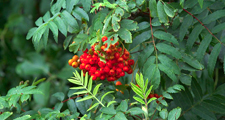Upland Ash Woodland- W9
Fraxinus excelsior – Sorbus aucuparia – Mercurialis perennis woodland.
Character Area
North Pennines, Pennine Dales Fringe.
Character
Riparian woodlands of incised limestone gorges and upland gills.
Geology
Carboniferous limestone.
Soils
Thin soils over limestone, basic brown earths.
Species
Ash and Wych Elm are dominant species. Downy Birch, Sessile Oak and Rowan are common. Hazel is often dominant in the understorey and influential in the canopy. Bird Cherry, Hawthorn and Holly are common. Elder and Grey Willow are occasionally present. Aspen is found in ravine sites.
Ground Flora & Fauna
Herb & fern rich. Dog’s Mercury, Bluebell, Primrose, Wood Anemone, Wood Avens, Dog Violet, Wood Sorrel, Sanicle, Wood Cranesbill, Globeflower, Marsh Hawksbeard. Lady Fern, Male Fern, Broad Buckler Fern, Hard Shield-fern. Alkaline bark of Ash supports rich lichen flora. Invertebrate fauna particularly important
Structure
Semi-natural woodlands have a high degree of species and structural diversity reflecting the complex interactions of terrain, soils and surface and ground water on typical gill/gorge sites. Riparian Ash woodlands may show transitions to Oak/Birch woodland (W11) on steeper upper slopes & base poor soils or Alder/Ash woodland (W7) on flushed slopes & wetter valley bottoms.
Management principles
- Prevent grazing by livestock or browsing by deer – particularly in small woods.
- Where grazing is long established, fit stocking periods & densities to conservation goals.
- Maintain and increase the numbers of old trees and dead wood.
- Low intervention approaches are usually best & particularly for small woods.
- Felling – minimise the scale of disturbance.
- Maintain areas of open ground.
- Use low-key establishment techniques – particularly natural regeneration.
- When planting is necessary use only native species of local origins.
Planting sites for new woods
Extensions to existing woodlands. Upland gills & ravines on limestone.
Design principles
Simple planting mixtures based on Ash and Hazel together with smaller numbers of minor species such as Birch, Oak and Rowan. Others species can be introduced in small numbers or left to colonise naturally. The provision of some open space and lower density planting may foster the development of a herb rich ground flora. Downy Birch could be used as a nurse species on exposed sites and its proportions in the canopy later reduced.
Further information
Forestry Commission Forestry Practice Guide 4: Upland Mixed Ashwoods can be downloaded from Forestry Commissions Publications pages.



